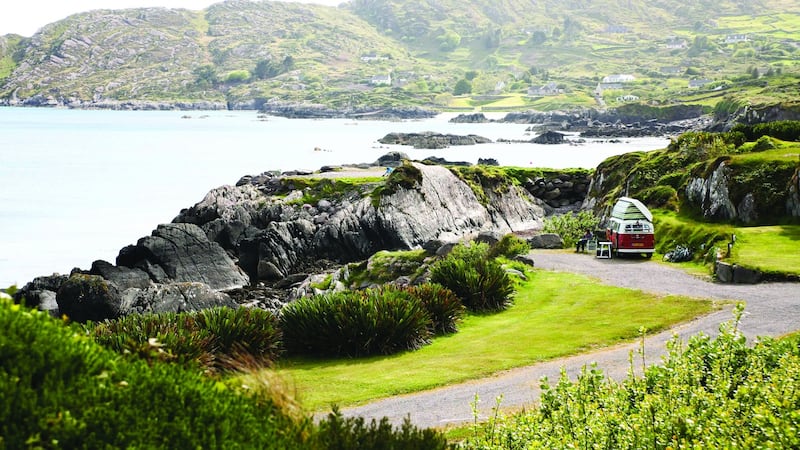A home on wheels that you can take with you to the most beautiful and remote spots in the country, that you sleep and cook in and keep clean yourself; could there be a more ideal, socially-distanced means of holidaying during a pandemic than in your own camper van?
Summer 2020, despite the shocking weather, has seen an unprecedented surge in interest in taking a break in the great outdoors. Campsites all over the country have signs tacked to their gates or posted on their websites, “Fully booked until 2021”.
As reported in the Motors pages of this newspaper at the end of July, sales of Volkswagen campervans in Ireland are up 25 per cent this year compared to 2019, and a whopping 1,000 per cent since dealerships reopened after lockdown on May 18th.

Conveniently yet coincidentally timed to capitalise on this new national obsession is Martin Dorey’s new guidebook, Take the Slow Road Ireland: Inspirational Journeys Round Ireland by Camper Van and Motorhome. Did he know something the rest of us didn’t?
“People are finally getting it, and getting into it,” he laughs over the phone from his home.
“I would hope that people are starting to realise, now more than ever, that flying is a really horrible way to travel. It is not safe from a planetary point of view, and now from a disease point of view either. In a campervan you can travel in a safer way and a more environmentally-friendly way, see great stuff along the way, and it offers the perfect isolation too.”
An avid campervanner (this is the third title in his Take the Slow Road series, after Scotland, and England and Wales), Dorey has been travelling regularly around Ireland for more than 25 years.
He took his first trip in a camper van in 1994, coinciding with the World Cup in the USA. He still remembers watching Ireland's opening match against Italy, "when Jackie's boys slipped one past Italy and made their small, fierce, world-beating and stunningly beautiful nation very, very proud indeed", in a bar somewhere near Waterford.
That game set the tone for the rest of that trip, and for the many return visits he has made in his van in the three decades since.
Driving routes
Take the Slow Road is more than just a guidebook. There are 24 driving routes detailed around the country, from the Old Military Road in Co Wicklow, to the Antrim Glens and the surf coast from Sligo to Bundoran in Co Donegal.
Along with simple hand-illustrated maps and chatty, easy to follow driving instructions, each chapter has a lengthy personal introduction, sharing memories and stories from Dorey's travels around Ireland over the years; from the morning of his wedding to his now ex-wife in Dungarvan in Co Waterford in 2000, to paddling out on surfboards in the early morning light to catch a photo with Fungie the dolphin with his current partner and travelling companion Lizzie.

Dorey's children regularly accompany him on his trips too, to visit their Irish family in Co Waterford, and his mother moved to Mullaghmore in Co Sligo to be with her partner several years ago, giving them yet another reason to visit Ireland and a new base from which to explore the country.
Does he have a favourite route?
"The Copper Coast from Tramore to Dungarvan," he says. "I've driven that road so many times and just love it. But I have to say, the west of the Ring of Kerry around Derrynane, Waterville and Caherdaniel is just heavenly."
Dorey takes his camera with him on every trip, and the book is packed with beautiful photographs of his VW Crafter loaded with surfboards, kayaks and bikes parked up on remote beaches, scenic piers, and stunning lakeshores.
Those hoping for specific recommendations on locations to wild camp may be disappointed; while the pictures taken on campsites are all well-captioned, the wild camping spots are not, and for good reason.
“Wild camping is a difficult thing to condone,” he says. “I don’t want to upset anyone, so I have only listed places that are legal.”
Wild camping
Generally Dorey spends three days wild camping for every night in a campsite – “for a proper wash” – and has only been asked to move along once in Ireland. He says locals are generally tolerant if you respect “no overnight parking” signs, keep a tidy camp, clean up when you arrive and before you leave, and contribute to the local economy by shopping and eating local. (Dorey is also the man behind the #2MinuteBeachClean, inspiring beachgoers to spend a few minutes cleaning up after every visit to the beach for a walk, surf or swim.)
“The message is that you have to be respectful,” he says. “You have to be discreet.”

For first-time caravaners there’s an essential kit list, and information on where and how to rent if you don’t own your own (yet). For the van lifers there are plenty of new routes to try, and travel tales and photos to inspire your next trip.
Since 2016 my husband and I have been travelling around Ireland every few weeks in our own Volkswagen Caravelle, which took tourists on hackney tours of the Ring of Kerry before we converted it into a two-berth camper.
The weekend after Dorey and I speak, we are due to head off on our first trip since lockdown, and are inspired by the book to try somewhere we haven’t been before, and choose Dorey’s favourite route: Waterford’s Copper Coast. Even off the record he’s reluctant to tell me where the pictures in that chapter were taken, when I tell him that’s where we’re headed.
We don’t find the ones in his pictures but discover two perfect coves of our own to park up in for the night. That’s the beauty of taking the slow road.
Take the Slow Road: Ireland by Martin Dorey is published by Bloomsbury






















